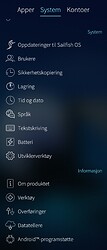I wonder how I can identify – within SFOS – which version of Android is underlying a SFOS installation? (I can’t find anything in the About the product/device section that informs me.)
That’s the version of app support and not the previously installed android version before flashing - I understood op meant the latter
A bit of fast reading …
I guess that is pretty hard to do.
Or somewhat easy if you know that you followed the flashing guide then you have the possibility of:
| Device | Android baseband version |
|---|---|
| Xperia X | 34.4 .A.2.118 (Android 8) |
| Xperia XA2 |
50.1 .A.13.123 (Android 8) 50.2 .A.0.400 (Android 9) |
| Xperia 10 | 53.0 .A.8.69 (Android 9) |
| Xperia 10 II |
59.0 .A.6.24 (Android 10) 59.1. A.2.169 (Android 11) |
| Xperia 10 III |
62.0. A.3.109 (Android 11) 62.1. A (Android 12) |
It’s a 10 ii on some version of 12, so not so easy I’m afraid …
but thanks, anyhow.
Hej!
Could Aida64 app tell you more and exakt of your equipment?
Anroid App Support still has nothing to do with the (all but replaced) Android version that was on the device pre SFOS - which in turn also is unrelated to the Android version the kernel used comes from.
This isn’t supposed to matter really, so i can’t imagine it being observable in SFOS. Perhaps some fastboot properties can be correlated with it, but even that feels like a longshot.
There are actually 3 android versions involved, right? The version that was installed before you flashed sfos, the binaries you installed while flashing sfos and appsupport.
For the system the first 2 influence your experience (see e.g. Echo cancelation in 10iii)
I guess you could even argue there is 4 if you mismatch the binaries with the SFOS kernel version (official instructions ask you to match these).
But i don’t think it is a good way to speak about versions of at lest the kernel and binaries to only go by the Android version. They have individual versioning schemes and several released/updated versions exists. What’s being replaced wasn’t supposed to matter in this way (that’s what the binaries are for), but apparently it does to some extent.
Unfortunately this does matter, and very much so on the Xperia 10 III, because Sony’s Android updates also update the firmwares on the firmware partitions for WLAN, Bluetooth, cellular modem, audio DSP, Camera etc.
But aside of negative effects (e.g. on the Xperia 10 III: “tinted screen”, “echo for callers” etc.), the “Android version that was on the device pre SFOS” cannot be determined after flashing SailfishOS.
I’m well aware. I was not contradicting that.
I even updated the phrasing here:
My argument is: since it isn’t/wasn’t supposed to work like this, i can’t see either SONY or Jolla having designed in functionality to handle that.
It would be interesting to verify if there is really no way to check which versions the firmware blobs are in. Maybe that could be a first step to only update those
I practically know nothing about this matter,but got struck with a thought about /proc/partitions. Maybe it’s possible to extract something from there?
Sorry if I’m just stupid.
I asked a bot for a script to list the root dir contents of all partitions unfortunatly mount fails…
thinking about it, those might just contain no filesystem…
#!/bin/bash
# List all partitions on /dev/sda
partitions=$(lsblk -lp -o NAME,FSTYPE,MOUNTPOINT | grep "/dev/sda" | awk '$2 == "" {print $1}')
# Function to mount partition read-only
mount_readonly() {
mount -o ro "$1" "$2"
}
# Function to unmount partition
unmount_partition() {
umount "$1"
echo "Unmounted $1"
}
# Loop through each partition and mount if unmounted
for partition in $partitions; do
# Check if partition is not mounted
if ! grep -qs "$partition" /proc/mounts; then
mountpoint="/mnt${partition}"
mkdir -p "$mountpoint" # Create mount point if it doesn't exist
mount_readonly "$partition" "$mountpoint" # Mount partition read-only
echo "Mounted $partition read-only to $mountpoint"
# List root directory contents
echo "Contents of $mountpoint:"
ls "$mountpoint"
# Unmount partition after listing contents
unmount_partition "$partition"
fi
done
running blkid is interesting as well. Unfortunatly many partitions do show no type.
we could run hashsums on a few partitions (eg md5sum /dev/sda73) and compare them. I wonder if one of those corresponds to the display driver…
[root@defaultuser]# md5sum /dev/sda73
0dfbe8aa4c20b52e1b8bf3cb6cbdf193 /dev/sda73
Got the same. We should compare a few of those and check which change depending on the android version installed before flashing sfos
OK, but no can do, right now. Might check when/if I can sailfish my X 10 V.
You can check it via fastboot using
fastboot getvar all
and then looking up in that command’s output for baseband version, which corresponds with the Sony’s exact Android update version installed (e.g. something like 62.1.A.0.675, which you can then google up to identify).
P.S. I believe that you can also query the baseband version directly using
fastboot getvar version-baseband
I got all the hashes here now: Android 13 and SailfishOS on xperia 10 III - #77 by thigg

